ASRock has continued the red and black theme of past Fatal1ty branded products but the styling has definitely been toned back to a more neutral colour scheme. Gone are the red DIMM and PCIe slots, in its place is more subtle red accenting on the motherboard PCB like ASUS also uses on its Z170 motherboards.
That said, given current motherboard market trends ASRock are perhaps limiting their audience by not offering a more neutral colour scheme with customisation options. Rival vendors have successfully used 3D Printing, RGB lighting, stickers, carbon fibre wraps and detachable pieces to give prospective buyers more customisation options. ASRock offers none of the aforementioned with this product which is a little disappointing.
Connectivity along the lower edge of the board is busy – HD Audio, a clear CMOS jumper, a BIOS selector switch, front panel connectors, TPM, COM and USB.
The BIOS chips have an unsightly yellow sticker on them which most buyers should consider removing to improve the aesthetic appeal. There's also a debug code reader and the first M.2 slot located in this same area.
The 3 PCIe 3.0 X16 lanes result in different configurations depending on whether a 40 or 28 lane CPU is used. For a 40-lane CPU the following configurations are available: 16X/16X/0X or 16X/8X/8X, for a 28-lane CPU 16X/0X/8X or 8X/8X/8X.
The two PCIe 1X slots are Gen 2.0 and get bandwidth from the chipset.
The CPU socket has a 12 phase hybrid-digital VRM solution and draws in power from a CPU EPS 8 pin connection. Capacitors in proximity to the CPU socket are ASRock's gold-coloured 12,000-hour (12k) rated units.
The Audio is provided by a Realtek ALC1150 codec that is unshielded and sits underneath the “Gaming Armour” on a isolated PCB. Nichicon Fine Gold Series capacitors and a Texas Instruments NE5532 headset amplifier further enhance the audio system.
Storage connectivity is provided through 10 SATA ports, of which two are shared with SATA Express, and two M.2 ports.
Both M.2 ports support SATA and PCIe devices, though when a 28-lane CPU is used the first M.2 socket (M2_1) supports only SATA type devices. The M.2 ports also support the optional ASRock U.2 kit but this is sold separately and not included as standard.
The rear I/O offers a nice blend of connectivity with two legacy USB 2.0 ports, a PS/2 combo port, four USB 3.0 ports, two USB 3.1 ports of which one is type-C, dual Intel LAN ports that support teaming, a clear CMOS button and six audio jacks (5 analogue 1 digital).
The antennae mounting points for the integrated WiFi module are also found in the rear I/O. Disappointingly, the WiFi solution is only rated at 433Mbps, which is significantly lower than the 867Mbps+ solutions we have seen on competing motherboards.
Underneath the motherboard all heatsinks are secured with standard Philips screws meaning easy removal for cleaning or installing waterblocks. There aren't any PCB reinforcement plates underneath as ASRock likely believes that the 8-layer PCB negates the need for this.
 KitGuru KitGuru.net – Tech News | Hardware News | Hardware Reviews | IOS | Mobile | Gaming | Graphics Cards
KitGuru KitGuru.net – Tech News | Hardware News | Hardware Reviews | IOS | Mobile | Gaming | Graphics Cards


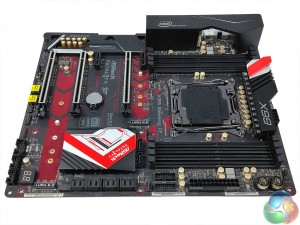
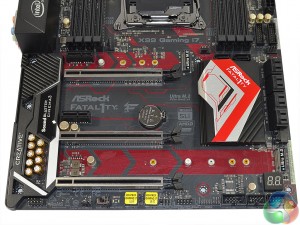
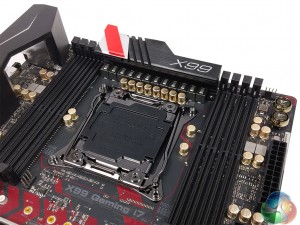
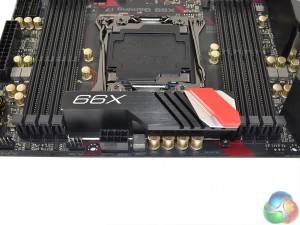
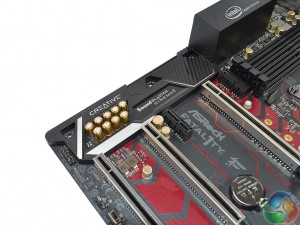
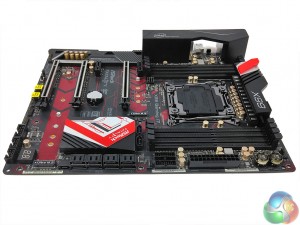
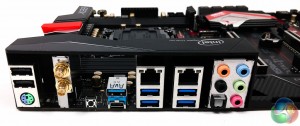
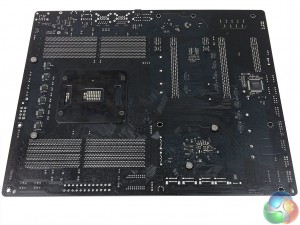

Any idea of price?
Yes it’s discussed on the final page – around £270 in the UK and $260 in the US.
260 USD isn’t 270 GBP, even after the eu referendum bollocks.
Id more likely expect something like;
260 USD / 220 GBP
320 USD / 270 GBP
Wouldn’t make sense at all for it to be more in GBP than USD.
I know how the currency conversion (plus being British tax) works. But that’s what retailers are selling the board for. It says in the review that ASRock’s pricing is more competitive in North America than it is in the UK.
It’s 324 euros here in Belgium.
This one looks good, but if I was to go with X99 on a budget I would consider their Taichi model.
I do like the looks of Taichi. Even Fatal1ty looking good, Taichi Black and white looks really good.
I was pleasantly surprised when I got my FX990 Killer, it is one solid board with wonderful audio and I really do like the UEFI set up way more than Asus or MSi. My only complaint with mine is the rather terrible northbridge heatsink design, it’s just a stylized block of anodized aluminum with 3 grooves cut in it, I could have gone down to the 970FX board with all better heatsinks, USB 3.1 with a type C port and support for 220watt CPU’s, but I would have given up a far more superior chipset (I run multiple PCIe devices, wireless, a USB 3.1 card and 2 different graphics cards), additional power to PCIe and audio
Really good stuff coming out from them, love their mobos.